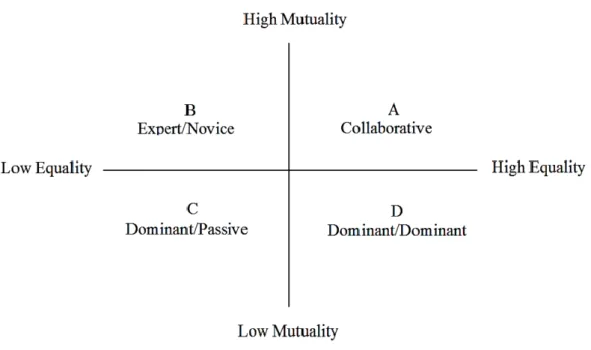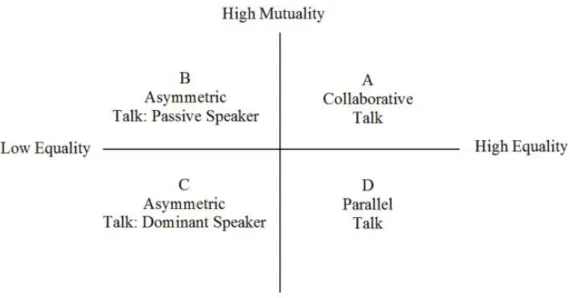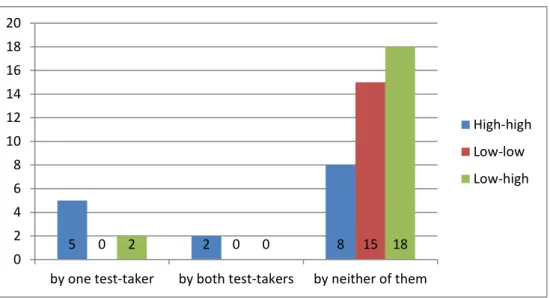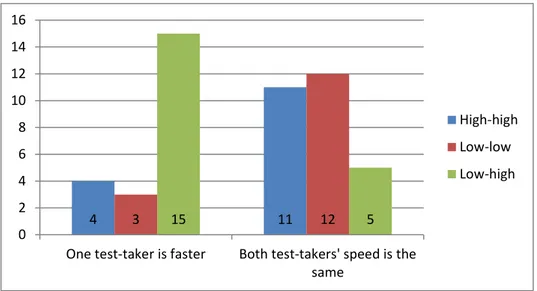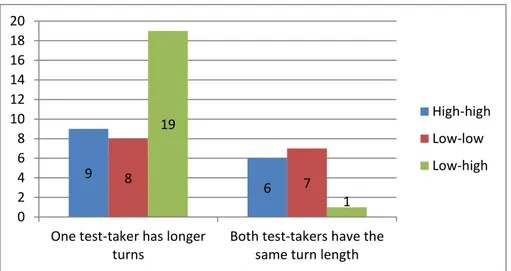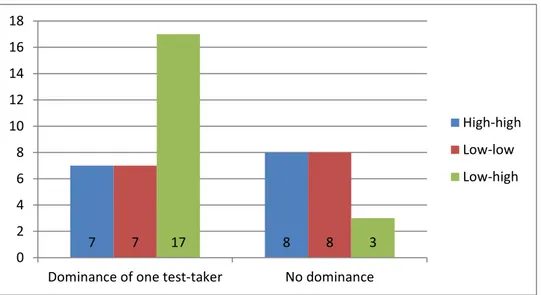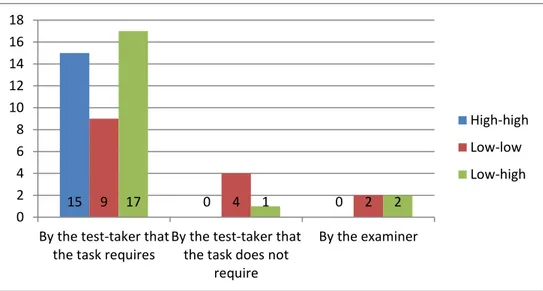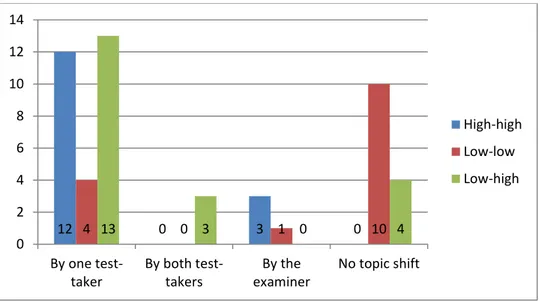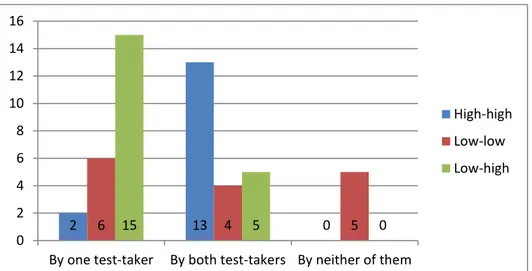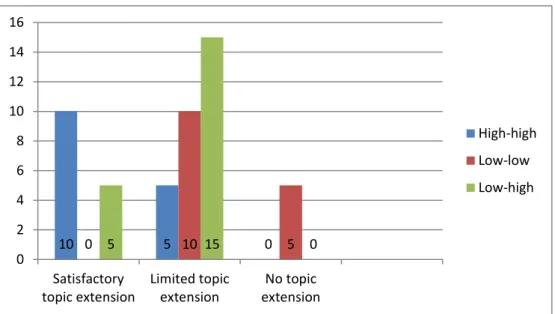To the memory of my grandmother and grandfather whom I have never met…
The Graduate School of Education of
İhsan Doğramacı Bilkent University
by
Esma Kot
In Partial Fulfilment of the Requirements for the Degree of Master of Arts
in
Teaching English as a Foreign Language
Ankara
İHSAN DOĞRAMACI BILKENT UNIVERSITY GRADUATE SCHOOL OF EDUCATION
Factors Influencing Dyadic Interaction in Paired Speaking Tests: Proficiency and Familiarity
Esma Kot November 2017
I certify that I have read this thesis and have found that it is fully adequate, in scope and in quality, as a thesis for the degree of Master of Arts in Teaching English as a Foreign Language.
---
Asst. Prof. Dr. Deniz Ortaçtepe (Supervisor)
I certify that I have read this thesis and have found that it is fully adequate, in scope and in quality, as a thesis for the degree of Master of Arts in Teaching English as a Foreign Language.
---
Prof. Dr. Julie Mathews-Aydınlı (Examining Committee Member)
I certify that I have read this thesis and have found that it is fully adequate, in scope and in quality, as a thesis for the degree of Master of Arts in Teaching English as a Foreign Language.
---
Asst. Prof. Dr. Zeynep Sağtaş-Bilki (Examining Committee Member)
Approval of the Graduate School of Education
---
ABSTRACT
FACTORS INFLUENCING DYADIC INTERACTION IN PAIRED SPEAKING TESTS: PROFICIENCY AND FAMILIARITY
Esma Kot
M.A in Teaching English as a Foreign Language Supervisor: Asst. Prof. Dr. Deniz Ortaçtepe
November, 2017
This study investigated whether familiarity and proficiency factors play a role in EFL learners’ use of interactional resources (i.e., turn-taking, topic management, repair and task management) and the emergence of interactional patterns (i.e.,
collaborative, parallel, asymmetric and blend) in paired speaking tests. The study was carried out with 100 EFL learners paired as low-low, high-high and low-high and with 36 EFL learners matched as unfamiliar and familiar in the oral proficiency exam at a state university in Turkey.
In order to place the participants for low-low, high-high and low-high groups, their scores in the proficiency exam which measured their reading, writing and listening skills as well as their vocabulary and grammar knowledge, and their scores in the oral proficiency exam were examined by the researcher. While 15 pairs were selected for the low-low and high-high groups separately, 20 pairs were selected for the low-high group. Then all 100 students (50 pairs) in the first cohort were asked whether their partners were their classmates or their friends in the exam and nine pairs out of 50 were detected as familiar. After that, nine unfamiliar pairs were
selected in order to compare them with the familiar ones. In total, 50 videos were listened to and transcribed by using the conventions suggested by Jefferson (2004). Forthwith, all transcriptions were analyzed in order to identify the interactional resources such as turn-taking, repair, topic management and task management employed by the test-takers during the test discourse. Following this process, the researcher drew upon the interactional resources in order to assign the interactional patterns such as collaborative, asymmetric, parallel and blend which took place during test-takers’ interaction with each other.
The results indicated that pairing two different proficiency level students is disadvantageous for the high level test-takers in terms of topic management, task management and repair. In contrast, while the low levels are advantageous in terms of topic and task management in particular, they are disadvantageous in terms of turn-taking. What is more, while high-high pairs create a collaborative pattern which is the most favorable one, low-low pairs usually create a parallel pattern. On the other hand, low-high pairs usually generate an asymmetric pattern due to the dominance of the high levels. Furthermore, the findings suggested that pairing two unfamiliar peer interlocutors seem more advantageous for the test-takers because unfamiliar pairs usually generate a collaborative pattern whereas familiar pairs usually create an asymmetric pattern during the test discourse.
In light of these findings, this study provided insights into how test-takers should be matched in paired speaking tests for the test administrators.
Key words: peer interlocutor, proficiency, familiarity, pairing system, paired speaking tests, interaction, interactional resources, interactional patterns
ÖZET
EŞLİ KONUŞMA SINAVLARINDA ÇİFT TARAFLI ETKİLEŞİMİ ETKİLEYEN FAKTÖRLER: YETERLİLİK SEVİYESİ VE AŞİNALIK
Esma Kot
Yüksek Lisans, Yabancı Dil Olarak İngilizce Öğretimi Tez Yöneticisi: Yrd. Doç. Dr. Deniz Ortaçtepe
Kasım, 2017
Bu çalışma aşinalık ve dil yeterliliği faktörlerinin İngilizceyi yabancı dil olarak öğrenen öğrencilerin, eşli konuşma sınavlarında kullandıkları etkileşimsel kaynaklar (yani; konuşma sırası, konu yönetimi, düzeltme yapma ve görev yönetimi) ve ortaya çıkan etkileşim modelleri (yani; işbirlikçi, parallel, asimetrik ve karma) üzerindeki rolünü incelemeyi amaçlamaktadır. Çalışma Türkiye’deki bir devlet üniversitesinde, yeterlilik seviyelerine göre sözlü konuşma sınavında düşük-düşük, yüksek-yüksek ve düşük-yüksek olarak eşleşmiş olan 100 öğrenci ve birbirine aşina ve yabancı olarak eşleşmiş 36 öğrenci ile gerçekleştirilmiştir.
Katılımcıları düşük-düşük, yüksek-yüksek ve düşük-yüksek gruplarına yerleştirmek için onların konuşma, yazma ve dinleme becerileri ile kelime ve dilbilgisi bilgilerini ölçen yeterlilik sınavındaki notları yanı sıra sözlü konuşma sınavında aldıkları notlar dikkate alınmıştır. Düşük-düşük ve yüksek-yüksek grupları için 15’er çift seçilirken, düşük-yüksek grubu için 20 çift seçilmiştir. Sonrasında toplam 100 (50 çift) öğrenciye konuşma sınavında partner oldukları kişiyle bir
yakınlığı olup olmadığı sorulmuştur ve 9 çiftin birbirlerini tanıdığı görülmüştür. Bu seçilmiş olan 9 aşina çiftle karşılaştırmak üzere birbirini tanımayan 9 çift daha seçilmiştir. Toplamda 50 video araştırmacı tarafından dinlenmiş ve Jefferson (2004) ‘ın tavsiye etmiş olduğu semboller dikkate alınarak konuşmalar yazıya dökülmüştür. Daha sonra, yazıya dökülmüş olan konuşmalar etkileşimsel kaynakları belirlemek üzere analiz edilmiştir. Bunu takiben, araştırmacı etkileşim modellerini
tanımlayabilmek adına bir önceki aşamada belirlenmiş olan etkileşimsel kaynaklardan yararlanmıştır.
Çalışmanın sonuçları farklı iki seviyedeki öğrenciyi eşleştirmenin yüksek seviyedeki öğrenciler için konu yönetimi, görev yönetimi ve düzeltme yapma kaynakları açısından dezavantajlı olduğunu göstermiştir. Bunun aksine, düşük seviyedeki öğrenciler için bu durum özellikle konu ve görev yönetimi açısından avantajlı bir duruma dönüşmektedir, fakat düşük seviyedeki öğrenciler de yüksek seviyede bir öğrenciyle eşleştiklerinde konuşma sırası açısından dezavantajlı durumdadırlar. Dahası, yüksek-yüksek olarak eşleşmiş öğrenciler en olumlu model olan işbirlikçi etkileşim modelini oluştururlarken, düşük-düşük olarak eşleşmiş öğrenciler paralel bir etkileşim modeli sergilemektedirler. Öte yandan, yüksek-düşük olarak eşleşmiş çiftler, yüksek seviyede olanların baskın olması sebebiyle, asimetrik bir etkileşim modeli oluştururlar. Ayrıca sonuçlar birbirini tanımayan iki öğrenciyi eşleştirmenin daha avantajlı olduğunu öne sürmektedir çünkü birbirini tanımayan öğrenciler sınav esnasında işbirliği içinde çalışırlarken, birbirine aşina olan çiftlerde konuşmacılardan birinin daha baskın olduğu ve bu sebeple asimetrik bir etkileşim modeli oluşturdukları gözlemlenmiştir.
Bu bulgular konuşma sınavı hazırlayanlar için eşli konuşma sınavlarındaki eşleştirme sistemi hakkında iç görü sağlamaktadır.
Anahtar sözcükler: eş konuşmacı, dil yeterliliği, aşinalık, eşleştirme sistemi, eşli konuşma sınavları, etkileşim, etkileşimsel kaynaklar, etkileşim modelleri
ACKNOWLEDGEMENTS
My one-year MA TEFL experience and writing this thesis involved both weal and woe. However, the woes turned into weal thanks to some individuals in my life. They were always there to encourage and support me. I would like to express my sincerest gratitude to those who accompanied me in this challenging process.
First and foremost, I would like to thank my thesis advisor Asst. Prof. Dr. Deniz Ortaçtepe for her excellent guidance and constructive feedback. Whenever I got confused, I knew that she would enlighten me with her wisdom. She was always there when I needed her. I feel privileged because she was my mentor. Without her support and guidance, it definitely would not be possible to complete this thesis.
I am also very grateful to Asst. Prof. Dr. Olcay Sert for sparing me his time and helping me determine this topic which was one of the hardest parts of this thesis. He was like a second advisor to me at the very beginning of this process. I would also like to express my gratitude to my committee members Prof. Dr Julie Mathews-Aydınlı and Asst. Prof. Dr. Zeynep Sağtaş-Bilki for their insightful comments and contributions to my study.
I also wish to express my gratitude to my institution, Bülent Ecevit
University, Prof. Dr. Mahmut Özer, the President, and Prof. Dr. M. Haluk Güven, the Vice President, for giving me the permission to attend this distinguished master’s program. I am also grateful to the Director of the School of Foreign Languages, Inst. Okşan Dağlı for giving me the permission to attend Bilkent MA TEFL and use the archives of the school to collect data.
I owe my deepest gratitude to Demet Kulaç Püren and Burcu Ak Şentürk who supported me with their guidance especially while applying to this program. I would like to extend my particular gratitude to Demet Kulaç Püren who livened my
Mondays up in Ankara. It was great to meet her on some Mondays and to feel away from my stress for a while. I also owe many thanks to Gulçin Özgöz Gülenç, Bahar Bıyıklı Koç and Nihan Güngör Ün for their encouragement and support before I started this journey, in particular.
And my precious classmates, MA TEFLers! Special thanks to Şeyma Kökcü, Kamile Kandıralı, Kadir Özsoy, Güneş Tunç, Tuğba Bostancı and Nesrin Atak (the MA TEFLer of hearts) for their invaluable friendship and constant encouragement throughout this challenging year. There were times when we felt hopeless, but we always encouraged each other because we knew that these tough times could be overcome by cooperation. This wonderful team made this year meaningful and bearable. I am so glad to know all of you and I believe that our friendship will last forever with the help of our ‘next’ plans. I would also like to express my sincerest gratitude to Damla Koç and Hale Nur Peneklioğlu for their support. It was great to live in the same city with them for one year and to forget about my responsibilities when I met them.
I also owe many thanks to UDK which made me the person who I am today and to the people there. Since this club has contributed to me a lot in terms of the discipline and diligence, it deserves to be mentioned here.
I would like to express my heartfelt gratitude to my dear fiancé Turan Can Artunç for his endless love and never-ending faith in me from the very beginning to the end. I have felt much stronger since I met him. It may be because my generous hero shares his luck with me or because he reminds me who I am. I know that I can
overcome all difficulties as long as he holds my hand. I would also like to thank him for coming to the U.S. with me and for letting me experience the happiest moments of my life with his proposal in San Francisco.
Last but not least, my earnest gratitude goes to my beloved family; my father Erol Kot, my mother Döne Kot and my sister Esra Kot for their unconditional love and unquestioning support. They have always believed in me and helped me believe in myself. They have always supported me every time when I have set a new goal. I know that they are always there whenever I need them and I feel so lucky to have such a family! I am particularly indebted to my dearest sister, Esra Kot for being my best friend and life-long mentor. I always depend on her maturity and consideration. Even though we have been too far away from each other, I know that she is always with me.
Thank you all who are somehow in my life! You have made this thesis possible.
TABLE OF CONTENTS
ABSTRACT………..….. iii
ÖZET ………...…….….. v
ACKNOWLEDGEMENTS ……….…….….. viii
TABLE OF CONTENTS ……….….. xi
LIST OF TABLES ………..…….….. xxi
LIST OF FIGURES ………..………...xxiii
CHAPTER I: INTRODUCTION ……….……….. 1
Introduction ………...………. 1
Background of the Study ………..……….. 2
Statement of the Problem ……….……….. 6
Research Questions ………...……….. 7
Significance of the Study ………..………….. 8
Conclusion ……….. 9
CHAPTER II: LITERATURE REVIEW………..….. 10
Introduction……….. 10
Language Testing………...……….. 10
Testing Speaking……….. 11
Types of Oral Interviews………... 12
Individual interviews (Candidate-Examiner) ………...….. 13
Paired speaking tests………... 14
Group tests……….. 16
Interactional competence ………...………... 16 Interactional resources………...……….. 19 Turn-taking………. 22 Repair……….. 23 Topic management……….. 24 Task management……….. 25 Interactional patterns……….. 26
Factors that affect test discourse……….. 30
Task Effect……….. 30 Interlocutor Effect………..………….. 31 Proficiency……….. 31 Gender………... 33 Personality………... 33 Familiarity……….….. 34 Conclusion……….. 37
CHAPTER III: METHODOLOGY………...….. 38
Introduction………. 38
Setting………...………….. 38
Selection of sample………...……….. 39
Students’ scores in the proficiency exam………...…..43
Students’ scores in the oral proficiency exam………...……….. 43
Research Design……….. 44
Data sources………..……….. 44
Video recordings of the oral proficiency exam……….…….. 44
Data analysis procedure……….. 46
Conclusion……….. 52
CHAPTER IV: DATA ANALYSIS………..……….. 53
Introduction………...….. 53
Results………...……….. 54
The Use of Interactional Resources and The Interactional Patterns in Paired Speaking Tests with EFL Test-takers Who Have the Same vs. Different Proficiency Levels……….………….. 54
Interactional resources employed by high-high, low-low and low-high pairs………... 54
Turn-taking in high-high, low-low and low-high pairs………….... 55
Overlap……….. 55
Turn speed………...……….. 57
Turn length………..………….. 60
Turn dominance……….... 62
Topic management in high-high, low-low and low-high pairs….... 64
Topic initiation……….. 64
Topic shift………...….. 68
Topic extension………. 70
Topic closure………. 77
Repair in high-high, low-low and low-high pairs……… 80
Task management in high-high, low-low and low-high pairs……. 85
Interactional patterns generated by high-high, low-low and low-high pairs………...……….. 89
Interactional patterns in low-low pairs………..….. 90
Interactional patterns in low-high pairs……….….. 91
The Use of Interactional Resources and The Interactional Patterns in Paired Speaking Tests with EFL Test-takers Who Are Familiar vs. Unfamiliar with Each Other……….……….. 94
Interactional resources employed by familiar and unfamiliar pairs….... 94
Turn-taking in familiar and unfamiliar pairs………..….. 94
Overlap……….. 94
Turn speed………...………….. 95
Turn length………..……….. 96
Turn dominance………..……….. 98
Topic management in familiar and unfamiliar pairs…………..….. 99
Topic initiation……….. 99
Topic shift………...……….. 100
Topic extension………...……….. 101
Topic closure………..……….. 103
Repair in familiar and unfamiliar pairs………..……….. 104
Task management in familiar and unfamiliar pairs………..105
Interactional patterns generated by familiar and unfamiliar pairs…….. 106
Interactional patterns in familiar pairs………...………….. 107
Interactional patterns in unfamiliar pairs………...….. 107
Conclusion……….. 109
CHAPTER V: CONCLUSION ……….. 111
Introduction ………..……….. 111
The Use of Interactional Resources in Paired Speaking Tests with EFL
Test-takers Who Have the Same vs. Different Proficiency Levels……….. 111
Turn-taking……….……….. 114
Topic management……….……….. 116
Task management………..……….. 118
Repair……….……….. 118
The Interactional Patterns in Paired Speaking Tests with EFL Test-takers Who Have the Same vs. Different Proficiency Levels………..….. 119
Discussion of the findings regarding proficiency as a factor in paired speaking tests……….. 122
The Use of Interactional Resources in Paired Speaking Tests with EFL Test-takers Who Are Familiar vs. Unfamiliar with Each Other ……...……….. 125
Turn-taking……….……….. 127
Topic management……….………….. 128
Task management………..……….. 129
Repair……….……….. 130
The Interactional Patterns in Paired Speaking Tests with EFL Test-takers Who Are Familiar vs. Unfamiliar with Each Other………...…….. 130
Discussion of the findings regarding familiarity as a factor in paired speaking tests……….. 132
Pedagogical Implications……….. 133
Limitations of the Study ………...……….. 134
Suggestions for Further Research……….……….. 135
Conclusion ………...……….. 136
APPENDICES ………..……….. 149
Appendix A: Role-play Tasks……….. 149
Appendix B: Duration of videos………...……….. 151
Appendix C: Rubric………..……….. 153
Appendix D: Transcription Conventions………..……….. 154
Appendix E: Descriptive Statistics of Interactional Resources in Low-Low Pairs……… 155
Appendix E.1: Descriptive Statistics of Overlap in Low-Low Pairs………….. 155
Appendix E.2: Descriptive Statistics of Turn Speed in Low-Low Pairs…..….. 155
Appendix E.3: Descriptive Statistics of Turn Length in Low-Low Pairs…... 155
Appendix E.4: Descriptive Statistics of Turn Dominance in Low-Low Pairs………... 156
Appendix E.5: Descriptive Statistics of Topic Initiation in Low-Low Pairs….. 156
Appendix E.6: Descriptive Statistics of Topic Shift in Low-Low Pairs…...….. 156
Appendix E.7: Descriptive Statistics of Topic Extension in Low-Low Pairs... 157
Appendix E.8: Descriptive Statistics of Topic Extension-2 in Low-Low Pairs………. 157
Appendix E.9: Descriptive Statistics of Topic Closure in Low-Low Pairs….... 157
Appendix E.10: Descriptive Statistics of Task Management in Low-Low Pairs………. 158
Appendix E.11: Descriptive Statistics of Repair in Low-Low Pairs………….. 158
Appendix F: Descriptive Statistics of Interactional Resources in High-High Pairs………...……….. 159
Appendix F.2: Descriptive Statistics of Turn Speed in High-High Pairs……... 159 Appendix F.3: Descriptive Statistics of Turn Length in High-High Pairs…….. 159 Appendix F.4: Descriptive Statistics of Turn Dominance in High-High
Pairs………... 160 Appendix F.5: Descriptive Statistics of Topic Initiation in High-High
Pairs... 160 Appendix F.6: Descriptive Statistics of Topic Shift in High-High Pairs…….... 160 Appendix F.7: Descriptive Statistics of Topic Extension in High-High
Pairs………...….. 161 Appendix F.8: Descriptive Statistics of Topic Extension-2 in High-High
Pairs………... 161 Appendix F.9: Descriptive Statistics of Topic Closure in High-High
Pairs………...….. 161 Appendix F.10: Descriptive Statistics of Task Management in High-High
Pairs……….….... 162 Appendix F.11: Descriptive Statistics of Repair in High-High Pairs……...….. 162 Appendix G: Descriptive Statistics of Interactional Resources in Low-High Pairs……...….. 163 Appendix G.1: Descriptive Statistics of Overlap in Low-High Pairs……...….. 163 Appendix G.2: Descriptive Statistics of Turn Speed in Low-High Pairs……... 163 Appendix G.3: Descriptive Statistics of Turn Length in Low-High
Pairs……...………....….. 163 Appendix G.4: Descriptive Statistics of Turn Dominance in Low-High
Appendix G.5: Descriptive Statistics of Topic Initiation in Low-High
Pairs…..………...….. 164 Appendix G.6: Descriptive Statistics of Topic Shift in Low-High Pairs…….... 164 Appendix G.7: Descriptive Statistics of Topic Extension in Low-High
Pairs………...….. 165 Appendix G.8: Descriptive Statistics of Topic Extension-2 in Low-High
Pairs………...…….. 165 Appendix G.9: Descriptive Statistics of Topic Closure in Low-High
Pairs………...….. 165 Appendix G.10: Descriptive Statistics of Task Management in Low-High
Pairs……….… 166 Appendix G.11: Descriptive Statistics of Repair in Low-High Pairs……...….. 166 Appendix H: Descriptive Statistics of Interactional Patterns in Low-Low
Pairs………...….. 167 Appendix I: Descriptive Statistics of Interactional Patterns in High-High
Pairs………...….. 168 Appendix J: Descriptive Statistics of Interactional Patterns in Low-High
Pairs………...….. 169 Appendix K: Descriptive Statistics of Interactional Resources in Familiar
Pairs………...….. 170 Appendix K.1: Descriptive Statistics of Overlap in Familiar Pairs……...….. 170 Appendix K.2: Descriptive Statistics of Turn Speed in Familiar Pairs……….. 170 Appendix K.3: Descriptive Statistics of Turn Length in Familiar Pairs……... 170 Appendix I.4: Descriptive Statistics of Turn Dominance in Familiar Pairs…... 171 Appendix K.5: Descriptive Statistics of Topic Initiation in Familiar Pairs….... 171
Appendix K.6: Descriptive Statistics of Topic Shift in Familiar Pairs………... 171 Appendix K.7: Descriptive Statistics of Topic Extension in Familiar
Pairs…... 172 Appendix K.8: Descriptive Statistics of Topic Closure in Familiar Pairs…….. 172 Appendix K.9: Descriptive Statistics of Task Management in Familiar
Pairs………...….. 172 Appendix K.10: Descriptive Statistics of Repair in Familiar Pairs………..….. 173 Appendix L: Descriptive Statistics of Interactional Resources in Unfamiliar Pairs………...….. 174 Appendix L.1: Descriptive Statistics of Overlap in Unfamiliar Pairs……….... 174 Appendix L.2: Descriptive Statistics of Turn Speed in Unfamiliar Pairs……... 174 Appendix L.3: Descriptive Statistics of Turn Length in Unfamiliar Pairs…... 174 Appendix L.4: Descriptive Statistics of Turn Dominance in Unfamiliar
Pairs………... 175 Appendix L.5: Descriptive Statistics of Topic Initiation in Unfamiliar
Pairs……...………... 175 Appendix L.6: Descriptive Statistics of Topic Shift in Unfamiliar Pairs……... 175 Appendix L.7: Descriptive Statistics of Topic Extension in Unfamiliar
Pairs………...….. 176 Appendix L.8: Descriptive Statistics of Topic Closure in Unfamiliar
Pairs………...….. 176 Appendix L.9: Descriptive Statistics of Task Management in Unfamiliar
Pairs………...…... 176 Appendix L.10: Descriptive Statistics of Repair in Unfamiliar
Appendix M: Descriptive Statistics of Interactional Patterns in Familiar
Pairs………...….. 178 Appendix N: Descriptive Statistics of Interactional Patterns in Unfamiliar
Pairs………...….. 179 Appendix O: Low Level Test-takers’ Scores………...……….….. 180 Appendix P: High Level Test-takers’ Scores………...………….….. 182 Appendix R: Color-coding………...………….….. 184 Appendix S: A Sample of the Collaborative Pattern…………...………….….. 185 Appendix T: A Sample of the Asymmetric Pattern……….…………... 186 Appendix U: A Sample of the Parallel Pattern……….….. 187 Appendix V: A Sample of the Blend (Collaborative+Asymmetric) Pattern….. 188 Appendix Y: A Sample of the Blend (Parallel+Asymmetric) Pattern……..….. 189
LIST OF TABLES Table Page 1 2 3 4 5 6 7 8 9 10 11 12 13 14 15
Resources (Adopted from Young, 2008, pp.71)
Interactional resources and interactional patterns analyzed in the study
Analysis of the interactional patterns
Excerpt 1: Sample of Overlap in a High-High Pair Excerpt 2: Sample of Turn Speed in a Low-High Pair Excerpt 3: Sample of Turn Length in a Low-High Pair Excerpt 4: Sample of Turn Dominance in a Low-High Pair Excerpt 5: Sample of Topic Initiation by the Test-taker that the Task did not Require in a Low-Low Pair
Excerpt 6: Sample of Topic Initiation by the Examiner in a Low-Low Pair
Excerpt 7: Sample of Topic Shift in a High-High Pair Excerpt 8: Sample of Topic Extension in a High-High Pair Excerpt 9: Sample of Topic Extension in a Low-High Pair Excerpt 10: Sample of Satisfactory Topic Extension in a High-High Pair
Excerpt 11: Sample of Limited Topic Extension in a Low-High Pair
Excerpt 12: Sample of Topic Closure by Both Test-takers in a High-High Pair 20 47 50 55 58 60 62 65 66 68 71 72 74 75 77
16 17 18 19 20 21 22 23 24 25 26 27
Excerpt 13: Sample of Topic closure by One Test-taker in a High-High Pair
Excerpt 14: Sample of Topic Closure by the Examiner in a Low-Low Pair
Excerpt 15: Sample of Repair Applied When It Was Required in a Low-High pair
Excerpt 16: Sample of Repair Which Was Not Applied Even though It Was Required in a Low-Low Pair Excerpt 17: Sample of Repair Which Was Not Applied Even though It Was Required in a Low-High Pair Excerpt 18: Sample of Task Management by the High Level Test-taker in a Low-High Pair
Excerpt 19: Sample of Task Management by the High Level Test-taker in a Low-High Pair
Excerpt 20: Sample of Task Management by the Examiner in a Low-Low Pair
The distribution of interactional patterns in high-high, low-low and low-low-high pairs
The distribution of interactional patterns in familiar and unfamiliar pairs
The use of interactional resources depending on the proficiency factor
The use of interactional resources depending on the familiarity factor 78 78 81 82 83 86 86 87 93 109 113 126
LIST OF FIGURES Figure Page 1 2 3 4 5 6 7 8 9 10 11
Interactional patterns in writing (adopted from Wang, 2015, p. 10)
Interactional patterns in dimensions of mutuality and equality (Adopted from Wang, 2015, p. 11)
Distribution of the dyads
Distribution of overlaps in high-high, low-low and low-high pairs
Distribution of turn speed in high-high, low and low-high pairs
Distribution of turn length in high-high, low and low-high pairs
Distribution of turn dominance in high-high, low-low and low-high pairs
Distribution of topic initiation in high-high, low-low and low-high pairs
Distribution of topic shift in high-high, low and low-high pairs
Distribution of topic extension in high-high, low-low and low-high pairs
Distribution of topic extension in high-high, low-low and low-high pairs 27 29 42 56 59 61 63 67 69 73 76
12 13 14 15 16 17 18 19 20 21 22 23 24 25 26 27 28 29
Distribution of topic closure in high-high, low and low-high pairs
Distribution of repair in high-high, low-low and low-high pairs
Distribution of task management in high-high, low-low and low-high pairs
Distribution of interactional patterns in high-high pairs Distribution of interactional patterns in low-low pairs Distribution of interactional patterns in low-high pairs Distribution of overlap in familiar and unfamiliar pairs Distribution of turn speed in familiar and unfamiliar pairs Distribution of turn length in familiar and unfamiliar pairs Distribution of turn dominance in familiar and unfamiliar pairs
Distribution of topic initiation in familiar and unfamiliar pairs
Distribution of topic shift in familiar and unfamiliar pairs Distribution of topic extension in familiar and unfamiliar pairs
Distribution of topic closure in familiar and unfamiliar pairs Distribution of repair in familiar and unfamiliar pairs
Distribution of task management in familiar and unfamiliar pairs
Distribution of interactional patterns in familiar pairs Distribution of interactional patterns in unfamiliar pairs
79 84 87 89 90 92 95 96 97 98 99 100 102 103 104 106 107 108
CHAPTER I: INTRODUCTION
Introduction
Designing speaking tests has always been a hotly debated issue in language testing. While discrete-point tests or techniques such as dictation and reading aloud were used for the purpose of assessing learners’ speaking skills in the past, the rise of communicative language teaching in the 1970s led to an increase in performance tests which require the test-takers to have a conversation with an interlocutor. Even though individual interviews gained acceptance as a norm to test speaking skill at first, the emphasis on pair and group work in the classroom due to the
communicative movement (Taylor & Wigglesworth, 2009) and the advent of interactional competence (Kramsch, 1986) have brought paired speaking tests into prominence.
Brooks (2009) claimed that paired speaking tests allow the test-takers to engage in more interaction and negotiate the meaning more in contrast to individual interviews. Still, the co-constructed nature of interaction in these tests brings about some arguments related to their implementation. Since the test-takers’ performances are linked to each other, there is a possible interlocutor effect during the test
discourse. Therefore, test-taker characteristics such as familiarity with partner, proficiency, gender and personality have been a concern in implementing paired speaking tests. Hence, this study will investigate whether interactant related factors (i.e., familiarity and proficiency) play a role in a) EFL learners’ use of interactional resources and b) the emergence of interactional patterns in paired speaking tests.
Background of the Study
L2 oral proficiency can be defined as test-takers’ ability to communicate with interlocutors, which aligns with Bachman’s (1990) theoretical framework of
communicative language ability. Upon the advent of the communicative movement, communicative competence became the focus of language teaching and offered some alternatives to the language testing field. This communicative approach to speaking tests led to the predominance of performance tests, particularly individual tests such as interviews (McNamara & Roever, 2006). Several techniques such as picture description, face-to-face interaction and oral proficiency interviews have been used for the purpose of assessing language learners’ speaking skills (Birjandi, 2011). However, once interactional competence was proposed as an alternative theoretical framework to communicative competence (Sun, 2014), the established notions of communicative competence were challenged (Galaczi, 2013) and pair and group work activities gained importance in the language learning context (Taylor & Wigglesworth, 2009). Accordingly, paired speaking tests have been brought to forefront. In a paired speaking test, instead of being interviewed by an examiner who acts as an interlocutor, test-takers interact with each other in the presence of two examiners one of whom is an interlocutor and the other one is an assessor. This format possesses some advantages such as having the feature of leading to positive washback in the classroom (Messick, 1996) since it increases the use of pair and group work in language classrooms. In addition, test-takers may feel more comfortable since they share their anxiety (Saville, & Hargreaves, 1999). Additionally, paired speaking tests allow more interaction and negotiation of
interlocutors may have the chance to display their interactional competence more effectively in these tests.
In the field of SLA, interactional competence was first introduced by
Kramsch (1986) who claimed that the main goal of developing students’ proficiency in a foreign language should be to improve their interactional competence. It was later addressed by He and Young (1998) within Interactional Competence theory and they stated the importance of participating in ‘interactive practices’ so as to have interactional competence. (p.7) Young (2011) stated that “Interactional competence is not the knowledge or possession of an individual person, but is co-constructed by all participants in a discursive practice”. (p.428) In other words, interactional competence is not the responsibility of an individual but it is jointly constructed. During the interaction both speakers need to contribute to the conversation and use interactional resources such as turn-taking, repair, and topic management, which will allow the speakers to generate a particular interactional pattern during the
conversation.
Interactional patterns were first identified by Storch (2001, 2002) in his study on ESL writing pairs as; collaborative, dominant/passive, expert/novice, and
dominant/dominant. Drawing upon Storch’s (2001,2002) model, Dimitrova-Galaczi (2004) observed three interactional patterns during a paired speaking test and termed these patterns as collaborative, asymmetric, parallel and blend. The researchers suggested that in a collaborative pattern, interlocutors extend their own topics and are interested in their partners’ topics as well. In other words, they contribute to the talk cooperatively. On the other hand, in a parallel pattern, test-takers develop their own topics, but they do not extend their partners’ topics. Moreover, in an asymmetric pattern of interaction, there is an imbalance in the talk as the pairs in such a pattern
are observed as one dominant and one passive. Lastly, if the interlocutors generate two patterns together during their talk, it is referred to as a blend pattern (Galaczi, 2008). It was verified in Galaczi’s (2008) study that test-takers who get involved in the collaborative pattern get the highest scores from assessors. What is more, to be able to generate the collaborative pattern, interlocutors need to know how language is used in talk-in-interaction and have a good grasp of interactional resources such as turn taking, repair, and sequence organizations that underlie all talk-in-interaction (Markee, 2008). The features of turn-taking management are turn length, speed and dominance (Dimitrova-Galaczi, 2013; Ducasse & Brown, 2009; Ducasse, 2010; Watanabe & Swain, 2007). More specifically, turn length means the utterance length or the number of turns a speaker takes and turn speed refers to how fast the two partners respond to each other. Furthermore, how interlocutors compete for the floor indicates turn domination (Ducasse & Brown, 2009). When it comes to repair strategies, studies have identified several repair strategies such as initiated self-repair, self-initiated other self-repair, other-initiated self-self-repair, other-initiated other repair, repetition, paraphrase, confirmation checks, clarification requests and
comprehension checks (Drew, 1997; Schegloff et al., 1977; Schegloff, 2000). Repair is a term which helps speakers fix communication breakdowns. These strategies do not serve only the purpose of correction, but they are also used to deal with problems resulting from the mishearing and misunderstanding. On the other hand, task
management refers to the extent to which interlocutors help each other to accomplish the task. In order to complete the task successfully, interlocutors should meet the requirements of the task. As for topic management, topic extension and topic shift are some of the concepts which constitute it. While in a conversation, interlocutors need to help each other to initiate and build upon a topic to maintain the
conversation. If the interlocutors do not extend the topic or resort to topic shift when necessary, it may impair the interaction between them. Thus, employing all those interactional resources such as repair, turn-taking and topic management is essential in order not to cause communication breakdowns in daily interactions.
Paired speaking tests may seem simple to implement; however, in an actual assessment context it can be extremely complex since test-takers’ performance may be influenced by various tasks, examiners or interlocutors (Davis, 2009). From the mid-1990s, testers have been challenged by the issue that the spoken language displayed in a test is influenced during co-constructed interaction (He & Young, 1998 ; Jacoby & Ochs, 1995; McNamara, 2001) and these challenges have led to an increase in empirical studies of the nature of oral proficiency exams (Ducasse, 2009). Particularly, the effect of the other test-taker has been a big concern in paired
speaking tests as both of the test-takers contribute to the interaction and their performances are linked to one another (Luoma, 2004; McNamara, 1997; Weir, 2005). As McNamara (1996) suggested “the age, sex, educational level, proficiency or native speaker status and personal qualities of the interlocutor relative to the same qualities in the candidate are all likely to be significant in influencing the candidate's performance". (p.86) Since the interaction is jointly constructed in paired speaking tests, the interactional resources employed by each interlocutor may influence the interaction that occurs during the test discourse. Moreover, the raters determine the scores looking at the interactional resources employed by test-takers and types of interactional patterns may have an impact on the rater scores (Galaczi, 2008). Therefore, peer interlocutor is an important source of variation which may either positively or negatively influence the discourse of the exam, and therefore a test-takers’ performance and/or score (Csepes, 2002).
Statement of the Problem
Paired speaking tests not only better resemble natural conversation (Ducasse & Brown 2009), but also give test-takers the possibility of producing more varied patterns of conversation (Birjandi, 2011). Nevertheless, whether paired tests are more advantageous than traditional face-to-face interviews is a controversial issue, since the interaction is jointly constructed in these tests (Young & He, 1998). Furthermore, several researchers have suggested a possible interlocutor effect on test-takers’ scores (Davis 2009; Galaczi 2008; Iwashita, McNamara & Elder, 2001) and on interaction (Lazaraton & Davis, 2008) during the test-taking discourse. Variables such as gender (e.g., Brown & McNamara, 2004; O’ Loughlin, 2002; O’ Sullivan, 2000), personality (e.g., Berry, 2004, 2007), familiarity with partner (e.g., Norton, 2005; O’ Sullivan, 2002), and individual’s proficiency (e.g., Davis, 2009; Dobao, 2012; Gan, 2010; Lazaraton & Davis, 2008; Nakatsuhara, 2006) have been found as factors which affect the takers’ performances to some extent. Among these test-taker variables, especially proficiency, personality and interlocutor familiarity on peer-to-peer interaction appear to have received the most extensive attention (Van Moere, 2014). While the studies investigating familiarity have mostly explored its role on test-takers’ linguistic performances, which have been measured by
quantitative methods (e.g., O’Sullivan, 2002), few studies have been conducted on how actual interaction is affected by test-takers’ proficiency levels (e.g., Galaczi, 2014; Gan, 2010). More specifically, to the best knowledge of the researcher, no studies have been carried out to explore whether pairing test-takers randomly without considering their proficiency levels or familiarity with each other would play a role in their use of interactional resources such as repair, turn-taking, topic management
and task management and the emergence of interactional patterns during the test discourse.
At the local level, in a state university in Turkey, for oral exams, students are paired randomly, regardless of their proficiency levels or familiarity with each other. Much as students take the placement exam at the beginning of the first and second semester, this exam does not measure their interactional competence. Therefore, there is the possibility to pair a low level student with a high level student in speaking tests. Galaczi (2014) claims that low level students have difficulty in engaging in interactions with their interlocutors. This means there is the risk that low level students who are paired with high levels may not be able to use the interactional resources and pairing system may affect the interaction between test-takers. On the other hand, while some students are paired with their classmates, others are matched with a stranger, which may turn out to be an advantage or a disadvantage in the test discourse. The aforementioned problems may affect the interaction that takes place in paired speaking tests. Once the interaction is affected by any of these factors, interlocutors may decrease each other’s performances or assessors may distort the scores, which will destroy the reliability of the test results in the end.
Research questions
The present study aims to investigate whether interactant related factors (i.e., familiarity and proficiency) play a role in a) EFL learners’ use of interactional resources and b) the emergence of interactional patterns in paired speaking tests. To achieve this aim, this study approaches interaction from two angles; first,
interactional resources such as repair strategies, turn-taking, topic management and task management, and second, interactional patterns such as asymmetric, parallel, and collaborative and blend. In this sense, the research questions are;
1) How do the use of interactional resources and the emergence of interactional patterns vary in paired speaking tests with EFL test-takers
a) who have the same vs. different proficiency levels? b) who are familiar vs. unfamiliar with each other?
Significance of the Study
Inasmuch as the interaction is co-constructed in dyadic tests, it can be influenced by factors such as proficiency and familiarity in a positive or negative manner. In this regard, this study may contribute to the field by indicating various interactional resources employed by low and high level test-takers and it may shed light on whether pairing EFL test-takers regardless of their proficiency levels and their familiarity with each other plays a role in the use of these resources and interactional patterns occurring during the test discourse. Hence, it may strengthen the theoretical basis of interactional competence and its components such as interactional patterns and interactional resources in the literature.
It may also pay dividends to the local institution, especially to the test administrators, in terms of how they should implement paired speaking tests. It may provide insights into whether the test administrators need to take into account the proficiency and familiarity factors while pairing the students so that test-takers can take the opportunity to co-construct a meaningful interaction in the test discourse. In addition to offering implications at the testing level, it may also offer some
suggestions to language teachers at the teaching level. Being aware of the
interactional resources, teachers can teach those resources in the classroom setting and address the communication problems of students more effectively. Furthermore, curriculum and material development units may benefit from this study to integrate these resources into the syllabus.
Conclusion
In this chapter, a brief introduction to the literature on paired speaking tests together with their potential advantages and disadvantages and interactional
competence along with interactional resources and interactional patterns have been provided. Furthermore, the background of the study, the statement of the problem, research questions, and the significance of the study has been covered. The next chapter will present the relevant literature on oral proficiency interviews,
interactional competence and its related concepts, and factors which influence the test discourse in paired speaking tests.
CHAPTER II: LITERATURE REVIEW
Introduction
The aim of this chapter is to review the current literature in relation to this study which investigates the role of the proficiency and familiarity factors on
interaction in paired speaking tests. The literature will be discussed in three sections. In the first section, starting with a brief introduction to language testing, testing speaking and types of oral interviews are presented. After explaining the features of each oral interview format, their advantages and disadvantages are covered
separately with an extensive focus on paired speaking tests. In the second section, the literature on interactional competence and related concepts such as interactional resources and interactional patterns are presented. In the last section, after
mentioning the factors which affect the test discourse, a summary of related studies on factors such as task effect and interlocutor effect are presented separately with a particular focus on test-taker proficiency and familiarity.
Language Testing
The language testing field has undergone some changes up to the present time. For example, between the 1960s and the 1970s language testers designed tests which assessed learners’ ability “as consisting of skills (listening, speaking, reading and writing) and components (e.g. grammar, vocabulary, pronunciation) and an approach to test design that focused on testing isolated ‘discrete points’ of language” (Bachman, 2000, pp. 2-3). During these years, the focus was on testing single units (Oller, 1979). That is to say, the tests designed to gauge learners’ language
knowledge tested only one item of the language at a time. The 1980s witnessed the impact of communicative competence, which brought on the start of the shift from discrete-point tests to performance-based tests with the idea of using communicative and authentic language tests put forward by Morrow (1979). After communicative competence was proposed by scholars such as Widdowson (1978; 1979; 1983), Savignon (1972; 1983), and Canale and Swain (1981), the existing testing system started to be criticized severely. These scholars perceived language use as a dynamic process taking place in a situational context. In other words, they advocated asking learners to engage in the language use rather than the language itself by designing a context and evaluating their real performances. This communicative view pushed the language testers to pay regard to the discourse and sociolinguistic issues while designing the tests (Bachman, 2000).
Although the language testing field has come a long way in terms of
employing communicative tests, implementation of these tests is still a hotly debated issue, especially to test learners’ speaking skills.
Testing Speaking
Testing speaking has been a controversial issue in the field of language testing since there are a number of factors, that should be taken into consideration by testers such as “construct definition, predictability of task response, interlocutor effect, the effect of characteristics of the test-taker on performance, rating-scale validity and reliability, and rater reliability” (O’Sullivan, 2008, p.1). Moreover, not only test developers play a role in assessing learners’ speaking skill, but also the other participants such as test-takers, interlocutors and assessors are highly important to the test discourse (Alderson & Bachman, 2004). Therefore, it is an accepted view
that assessing speaking skill is more difficult compared to testing the receptive skills of listening and reading in particular.
The views that testing should have a positive washback on teaching and learning and that testing and teaching are interwoven both influenced the dimension of testing speaking skill. Since there is an emphasis on performance-based speaking activities in language classrooms, it is also possible to see the implementation of performance tasks in speaking exams. For this reason, while in the past, learners’ speaking skills were assessed through discrete-point tests, currently performance-based tests, which allow more interaction and negotiation of meaning are
implemented.
It is suggested that performance tasks that test-takers engage in should represent the real-life situations that they may confront with and these tasks should enable test-takers to have a natural conversation (Weir, 1990). This view entailed the use of various types of oral interviews for the purpose of testing learners’ speaking skills.
Types of Oral Interviews
Oral interviews can be categorized into three in terms of the number of test-takers that they involve; individual, paired and group tests. An individual test, which is also called as candidate-examiner test, allows only one test-taker and an examiner to have a conversation, whereas paired and group tests allow at least two test takers to interact with each other in the presence of an interlocutor and an assessor. Hence, the conversational nature of speaking skill has recently launched the use of paired and group test trend (Van Moere, 2013).
Individual Interviews (Candidate-Examiner). Individual interviews have
been widely used since the early 20th century for the purpose of assessing the speaking skills of language learners. These tests have been employed by many government institutions such as the Foreign Service Institute (FSI) and Defense Language Institute (DLI), and nongovernment institutions such as the Educational Testing Service (ETS) and the American Council on the Teaching of Foreign Languages (ACTFL) (Johnson, 2000). In a typical Oral Proficiency Interview (OPI) test, there is usually an examiner and a test-taker whose performance is assessed by the examiner as well as a second rater during the exam. While individual interviews had emphasized dictation and pronunciation before the World War II, interaction and performance gained importance later on (Fulcher, 2003).
According to the proponents of individual interviews (e.g., Cubillos, 2010; Kenyon & Malabonga, 2001), these tests provide an authentic test discourse and context since test-takers have the chance to get involved in a real-life conversation in these tests. Advocates of individual interviews further claimed that individual
interviews have high validity in testing learners’ speaking ability because these tests are widely used by notable institutions. However, the construct validity of individual interviews was brought to the table in critical discussions by several researchers. For instance, Fulcher (2003) stated that the fact that individual interviews are employed in a widespread manner does not mean that they have high validity as the widely use of them does not prove that individual interviews are the best way of assessing learners’ speaking skills. For this reason, the interactional organization of individual interviews and natural conversation has been compared in many studies (e.g.,
Johnson, 2001; Lazaraton, 2002; Van Lier, 1989; Young & Milanovic, 1992; Young, 1995; Young & He, 1998). All of these studies have agreed that the discourse of
individual interviews does not resemble the natural conversation in terms of speakers’ turn-taking (Okada, 2010). While in an ordinary conversation both speakers have equal rights to take the stage, there is an asymmetric contingency between the examiner and the test-taker in an individual test discourse (Green 2014; Van Lier 1989). In other words, examiners gain an edge over the test-takers and they determine who will take turns or on what topic they will discuss during the test discourse (Okada, 2010). Therefore, their findings suggested that OPIs may have weak construct validity.
Paired speaking tests. The move towards a more communicative approach to
language teaching has increased the use of pair work activities since the 1970s (Taylor, 2011). Considering that testing is an indivisible part of teaching, this
approach has influenced not only the language teaching, but also the language testing field to a great extent (Ducasse & Brown, 2009) and the use of paired and group speaking tests both in classroom and assessment contexts has been more popular (Galaczi, 2014).
Paired speaking tests were first introduced by Cambridge ESOL in the First Certificate of English (FCE) examination in 1996 (Saville & Hargreaves, 1999; Taylor, 2000). In a typical paired speaking test, two test-takers interact with each other “in the presence of two examiners, one acting as an assessor and the other as an interlocutor” (Birjandi, 2011, p.171). To put it another way, test-takers engage in peer-peer interaction rather than candidate-examiner interaction in the paired format (Taylor & Wigglesworth, 2009). Much as the examiner takes part in the conversation to some extent, interaction is controlled by the test-takers, not by the examiner (Galaczi, 2008). Eygud and Glover (2001) asserted that peer interaction is more balanced in terms of quantity of talk, and topic initiation and extension when the
examiners play a minimal role in the test discourse, which turns out to be an advantage of paired speaking tests.
Several researchers suggested more potential benefits of paired format. To exemplify, Kormos (1999) claimed that paired speaking tests allow the test-takers to display their conversational management skills and manage the conversation better. Moreover, others have argued that test-takers approach these tests more positively (Egyud & Glover, 2001), since being tested with a partner decreases their
communicative anxiety and stress (Ikeda, 1998; Norton, 2005; Saville & Hargreaves, 1999). Furthermore, it has been suggested that this format brings about positive washback in language classrooms as it leads to the growth of pair work and group discussion activities in language learning contexts (Ducasse & Brown, 2009; Saville & Hargreaves, 1999; Van Moere, 2013).
On the other hand, some scholars in the field asserted that paired speaking tests are problematic as the interaction is jointly constructed (McNamara, 1997; Swain, 2001; Young & He, 1998). McNamara (1997) and Swain (2001) proposed their concern regarding the assessment issue suggesting that although test-takers co-construct the interaction during the test discourse, their performances are scored and interpreted individually. What is more, the jointly created nature of discourse brings forward a possible peer-interlocutor effect both on scores (e.g., Davis, 2009; Galaczi, 2008; Iwashita, 2001) and interaction (e.g., Lazaraton & Davis, 2008) in paired speaking tests. Therefore, factors such as proficiency, familiarity, personality, identity and gender, which are brought to the test discourse by each test-taker, may influence the interaction or the spoken output while implementing these tests (Van Moere, 2013).
Group tests. In a typical group test, three or four test-takers interact with
each other in the presence of an examiner; however, the examiner does not take part in the conversation (Sandlund et al., 2016). In a group test, the main aim is to elicit discussion. For this reason, topic cards and pictures are used to create a discussion and to enable test-takers to interact with each other in these tests (Hasselgren, 2000; Sandlund & Sundqvist, 2013).
Studies which have focused on group tests mostly investigated topic
negotiation and turn-taking during the test discourse (Sandlund et.al, 2016). In these studies (e.g., Gan, Davison & Hamp-Lyons, 2009), it has been observed that group tests allowed test-takers to display their interactional skills better since test-takers need to have a control of the interaction to maintain the conversation. Greer and Potter (2012) stated that being tested in a group poses a challenge in turn-taking management for test-takers. Moreover, interlocutor effect on the test discourse and test-takers’ performance is another possible problem of these tests. Some studies (e.g., Gan 2010; Nakatsuhara 2011) have indicated that test-takers’ proficiency levels in a group test influence the interactional patterns which occur during the test
discourse.
In this section, testing speaking and types of speaking tests in the field of language testing were discussed and in the next section, the concepts of interactional competence, interactional resources and interactional patterns will be presented.
Interactional competence
Interactional Competence (IC) can simply be defined as the knowledge of communication rules within a specific context. In the field of SLA, there are a number of scholars (e.g., Hall, 1993, 1995; He & Young, 1998; Kramsch, 1986;
Young, 2008, 2011), who have discussed the concept of interactional competence. The concept was first put forward by Oksaar (1983) and in his interactional competence model; he focused on the factors which may affect the construct of interactional competence. He claimed that paralinguistic features, nonverbal
behavior, and sociocultural norms, which he named “cultureme and behavioureme” as well as extraverbal behavior such as proxemics, time and space may all influence interactional competence (1983, pp. 247).
The impact of interactional competence on the language testing field began to be felt with the proficiency movement put forward by Kramsch (1986). She
emphasized interactional competence by stating that teachers should improve their learners’ proficiency to make them interactionally competent. Moreover, she proposed that
interaction entails negotiating intended meanings, i.e., adjusting one‘s speech to the effect one intends to have on the listener. It entails anticipating the listener‘s response and possible misunderstandings, clarifying one‘s own and the other intentions and arriving at the closed possible watch between
intended, perceived, and anticipated meanings. (p.367)
To put it another way, interaction cannot be achieved individually, but it requires the collaboration between the interactants (Kramsch, 1986).
Kramsch’s (1986) definition of interaction was furthered with the notion of construction, which was proposed by Jacoby and Ochs (1995) later on. The co-constructed nature of interaction was addressed by He and Young (1998) as well and they suggested that “interactional competence is not an attribute of an individual participant, and thus we cannot say that an individual is interactionally competent;
rather we talk of interactional competence as something that is jointly constructed by all participants”. (p.7) To put it more simply, interaction emerges with the help of both speakers; otherwise it cannot be regarded as interaction. Therefore, interactional competence requires negotiating meanings and creating intersubjectivity, which is the basis for interactional competence (Young, 2008). Intersubjectivity is a term which refers to “the conscious attribution of intentional acts to others and involves putting oneself in the shoes of an interlocutor” (Young, 2011, p. 430). In other words, it can be considered as an attempt to provide mutual understanding between interlocutors.
Another point discussed under interactional competence is the term discursive practices, which is also called interactive practices. Interactive practice was defined by Hall (1995) as “structured moments of face-to-face interaction—differently enacted and differently valued—whereby individuals come together to create, articulate, and manage their collective histories via the uses of sociohistorically defined and valued resources” (pp. 207–208). Young (2008) mentioned these practices as discursive practices defining those “recurring episodes of social interaction in context, episodes that are of social and cultural significance to a community of speakers”. (p. 57) He and Young (1998) stressed the interactive practice, which was an indivisible part of interactional competence and they stated that interactional competence cannot be considered separate from the interactive practice; it is even constructed in it. Interactants need to interpret the interactive practice first and shape their conversation accordingly in order to provide mutual understanding during the talk.
While constructing discursive practices, the resources such as verbal,
Among these resources, interactional resources are distinctive as they differentiate interactional competence from communicative competence (Young, 2000).
Interactional competence entails interlocutors to be aware of when they need to take turns, how they need to repair a trouble in a conversation or how they will manage a topic and employing interactional resources serve these purposes.
Interactional resources
Interactional competence was defined by Young (2008) as “a relationship between participants’ employment of linguistic and interactional resources and the contexts in which they are employed” (pp.100). From his definition of interactional competence, it can be inferred that he emphasized the use of linguistic and
interactional resources in particular contexts. The use of interactional resources is of great importance in terms of interactional competence, which will help the speakers maintain the flow during the talk.
There are several interactional resources that speakers can employ while engaging in a conversation. In his paper, Young (2000) suggested four interactional resources: understanding of sequences of speech acts that are associated with a particular discursive practice and the ability of participants to “construct a practice with a specific register”; apply a range of turn-taking strategies; and manage topic initiation, topic life, and topic choice (pp. 6–7).
Young (2008) furthered his suggestion of interactional resources later on and explained them in a more detailed way. He added three more resources and proposed that the seven resources which constitute the interactional competence are brought to the interaction by interactants. Table 1 presents the resources suggested by Young (2008).
Table 1
Resources (Adopted from Young, 2008, pp.71)
Identity resources
o Participation framework: the identities of all participants in an interaction, present or not, official or unofficial, ratified or unratified, and their footing or identities in the interaction
Linguistic resources
o Register: the features of pronunciation, vocabulary, and grammar that typify a practice
o Modes of meaning: the ways in which participants construct interpersonal, experiential, and textual meanings in a practice
Interactional resources
o Speech acts: the selection of acts in a practice and their sequential organization o Turn-taking: how participants select the next speaker and how participants know when to end one turn and when to begin the next
o Repair: the ways in which participants respond to interactional trouble in a given practice
o Boundaries: the opening and closing acts of a practice that serve to distinguish a given practice from adjacent talk
As is seen in Table 1, as well as interactional resources which comprise of speech acts, turn-taking, repair and adjacency pairs, interlocutors should have a good command of identity and linguistic resources in order to interact properly.
Furthermore, according to Markee (2008) there are three components of interactional resources:
• language as a formal system (including grammar, vocabulary, pronunciation); • semiotic systems, including turn-taking, repair, sequence organisation;
• gaze and paralinguistic features.
The fact that Markee (2011) stressed accuracy and fluency of interlocutors as indicators of their interactional competence was criticized by Walsh (2011) and he stated that interactional competence should be considered in light of the relationship between the linguistic and interactional resources as Young (2008) suggested.
In recent years, the interactional resources employed by the test-takers in paired and group tests have been examined in some studies (e.g., Galaczi, 2008; Gan, 2010; Galaczi, 2013). In those studies, the researchers explored whether the
interactional resources vary depending on the proficiency factor. For instance, Gan (2010) investigated the interactional resources employed by the test-takers in a higher-scoring and a lower-scoring group and compared them. The results of his study revealed that higher-scoring group got involved in each other’s topics a lot, which was demonstrated with the test-takers’ competition for the floor and with overlaps they caused during the test discourse. According to Gan (2010) test-takers’ contribution to each other’s topics indicates their endeavor to accomplish the task and their tendency to take control of the interaction that they engaged in. What is more, the members of the higher-scoring group supported the speaker with minimal responses and agreements when they were in the listener role. When it comes to the lower-scoring group in this study, they were not able to meet the requirements of the task, spoke with many pauses and the listener support was limited (i.e., lack of
minimal responses and agreements). Moreover, their topic extension was limited too since they did not engage in each other’s ideas. Galaczi (2013) also explored the use of interactional features across different proficiency levels and found out that topic development, listener support moves and turn-taking management varied as the test-takers’ proficiency level increased. More specifically, lower level test-test-takers’ other-initiated topic extension moves and listener support was limited and overlap was observed less frequently. However, higher level test-takers engaged in their partners’ topics more, supported the speaker when they were in the listener role and the
frequency of overlaps increased with the proficiency level.
All in all, it is apparent that in a conversation interlocutors need to possess interactional competence, which requires them to employ interactional resources in order to create mutual understanding and achieve intersubjectivity (Hall & Pekarek, 2011).
Turn-taking. Turn-taking is one of the most important organizations of
talk-in-interaction since talking one by one is needed not to cause overlapping and any communication breakdowns during the talk (Schlegloff, 2007). Interlocutors need to talk one at a time and they should be aware of when they will end their own turn and allow the next speaker to speak (Feldstein & Welkowitz, 1987).
Turn-taking management in talk-in-interaction involves three components: turn length, turn speed and turn domination (Ducasse & Brown, 2009; Ducasse, 2010; Watanabe & Swain, 2007). Turn length, which refers to the frequency of turns and utterances in a conversation, has been a topic of several studies (e.g., Csépes, 2009; Ducasse & Brown, 2009; Norton, 2005; Taylor, 1999). In these studies researchers determined the turn length by examining the number of turns and
utterance length. Additionally, turn speed refers to how fast interlocutors respond to each other. For instance, Ducasse and Brown (2009) identified turn speed by
analyzing the speed of interlocutors’ responses to each other in their study.
Moreover, turn domination was described by some scholars as a feature which shows how interlocutors struggle to stay on the stage (e.g., Ducasse & Brown, 2009;
Dimitrova-Galaczi, 2004).
Another interactional resource which is an integral part of interactional competence is repair, which will be discussed next.
Repair. As Faerch and Kasper (1983) put it, during a conversation
interlocutors may encounter communication problems; in situations of which they need to modify what they intend to say using repair strategies to be able to send a comprehensible message to the other speaker. Repair addresses “recurrent problems in speaking, hearing, and understanding.” (Schegloff, Jefferson & Sacks, 1977, pp.361). In addition, it helps interlocutors organize and maintain the conversation they engage in. In the literature, several types of repair have been identified such as self-initiated self-repair, self-initiated other repair, initiated self-repair, other-initiated other repair, repetition, paraphrase, confirmation checks, clarification requests and comprehension checks (Drew, 1997; Nagano, 1997; Schegloff et al., 1977; Schegloff, 2000).
Self-initiated self-repair can be observed in a situation that speaker 1 cannot find the right word, but after a small pause s/he finds it her/himself without a prompting from speaker 2 (Levinson, 1983). What is more, if speaker 1 makes an attempt to find the right word, but cannot find it and speaker 2 fills in it for speaker 1, it becomes self-initiated other repair.
